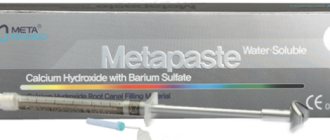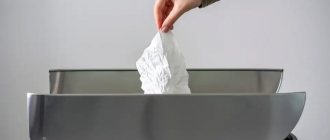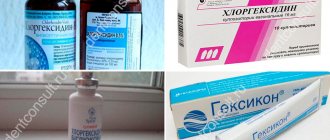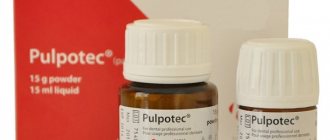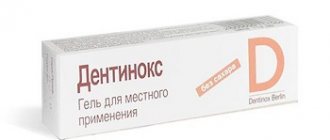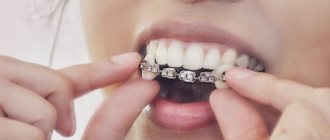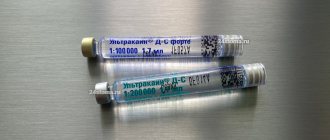Bactericidal and modified cements
— Unitem (Vladmiva) is a universal, improved zinc-phosphate dental cement with high mechanical strength and chemical resistance. The powder consists of zinc oxide, with modifying additives, and the liquid consists of orthophosphoric acid of reduced activity.
— Unicem bactericidal (Vladmiva) is a universal improved zinc-phosphate dental cement containing the optimal amount of a bacteriostatically effective form of silver. Used in pediatric dentistry for filling temporary teeth.
— -Adhesor (Spofa Dental) – zinc-phosphate cement, Adhesorfine (Spofa Dental) – modified zinc-phosphate cement with a fine structure.
— Phosphate cement containing silver. To improve the bactericidal properties, silver (1.547%) is added to the powder composition. The material is recommended as an insulating gasket when filling molars with metal and other fillings, for filling canals, in pediatric dentistry for filling temporary teeth. Analogs: Bactericidal Unitem (Vladmiva).
— Visphat cement refers to zinc phosphate cements. Its powder contains about 3% bismuth oxide. It hardens faster, is stronger than phosphate cement, and is less soluble. It is used as an insulating lining when filling teeth with metal fillings, silicate cements, acrylic and epoxy resins.
— Dioxyvisfate Dioxidine is included in the composition of this cement. Dioxyvisfate powder is a mixture of visfate and dioxidine, the liquid is orthophosphoric acid, partially neutralized with zinc oxide and aluminum hydroxide. Cement has bactericidal properties, has high mechanical strength, is slightly soluble, and is intended for filling temporary teeth, as a therapeutic and insulating spacer, for fixing inlays, pin teeth, and bridges.
Homework to understand the topic of the lesson:
Control questions:
1. What is the chemical composition of zinc phosphate cement powder and liquid?
2. What is the chemical composition of polycarboxylate cement powder and liquid?
3. What is the purpose of zinc phosphate cements?
4. What is the purpose of polycarboxylate cements?
5. Name the materials from the group of zinc-phosphate cements of domestic and foreign production.
6. Name the materials from the group of polycarboxylate cements of domestic and foreign production.
Classification of sealers (endosealers)
The classification of sealers includes, of course, not only newer materials, but also those that are no longer used in modern dentistry or are used in budget appointments. But for the historical aspect, and for general development, it would be nice to orientate ourselves in them.
Sealers are divided according to their consistency and combination of properties into:
- Plastic;
- Filers are primary solid.
Plastic sealers include non-hardening sealers and hardening sealers in their group. Currently, non-curing sealers are not used. Firstly, it is quite difficult to qualitatively fill the space between the dentin of the canal and gutta-percha, so as not to remove the material beyond the apex of the root, secondly, this group of materials has the super ability to dissolve under the influence of moisture, and at the end we have a poor-quality root canal filling, a newly developed pathological process.
A wide range of materials is included in the group of plastically hardening materials, including:
- Sealers based on resorcinol - formaldehyde resin;
- Sealers based on phosphate cement;
- Sealers based on epoxy resins;
- Sealer based on zinc oxide and eugenol;
- Sealer as an adhesive system;
- Polymer sealer with calcium hydroxide;
- Sealers based on silicone resin.
Sealer based on resorcinol - formaldehyde resin
Here you won’t open America to anyone - sealers based on resorcinol and formaldehyde resin are not used, because:
- A sealer based on resorcinol - formaldehyde resin has a high shrinkage, therefore, loss of high-quality sealing;
- Tooth staining pink;
- Formalin not only has a toxic effect on the body, but is also carcinogenic!
However, no matter how bad they talk about the bad qualities of a sealer based on resorcinol - formaldehyde resin, the sealer is currently being produced. All this is due to the bactericidal effect of formaldehyde.
in some cases, you can use a sealer based on resorcinol - formaldehyde resin, but extremely rarely:
- Gangrenous pulpitis;
- There is no way to pass through channels efficiently when they are either too narrow or curved;
- For some forms of apical periodontitis.
Sealers based on phosphate cement
Sealers based on phosphate cement were very common for some time, especially the peak of popularity occurred in the second half of the 20th century. Such a popular sealer based on phosphate cement was explained, first of all, by its active bactericidal effect and lack of sensitivity to moisture.
But the biggest disadvantage of this sealer is inflammation of the peri-root tissues due to the removal of the sealer beyond the root apex. In addition, this sealer has more disadvantages than advantages:
- Lack of radiopacity;
- Porosity of the material;
- Inconvenient working hours – fast curing;
- Impossibility of filling the root canal.
For this reason, sealers based on phosphate cement are of historical interest only.
Sealers based on epoxy resins
Sealers based on epoxy resins were insensitive to moisture, this was their main advantage, which dentists initially bought with the dream of filling root canals efficiently and without unpleasant consequences. However, epoxy resin sealers did not last long as a cool material.
Unitem white (50g+30ml), VladMiVa
Cement for fixing pins, crowns, bridges and inlays. Unitem has high mechanical strength and chemical resistance.
- Description
- Shipping and payment
- Reviews
Description
Unicem is a universal zinc phosphate cement formed by mixing zinc oxide powder and phosphoric acid solution.
Indications
- Fixation of crowns, bridges, pins, inlays.
- Filling teeth that are to be covered with a crown.
- Can be used as an insulating gasket when filling with silicate and silica-phosphate cements, as well as amalgams.
Characteristics
- Powder: 50 g.
- Bottle of liquid: 30 ml.
- Powder measuring cup: 1 pc.
- Dropper cap: 1 pc.
Compound
- Zinc oxide powder with modifying additives.
- Orthophosphoric acid of reduced activity.
Cement mixing process
Advantages
- High mechanical strength (90-120 MPa, depending on the ratio of powder and liquid).
- High adhesion to metal, plastic, porcelain, metal ceramics and other dental materials.
- Cement is resistant to the aggressive action of the moist environment of the oral cavity.
Instructions for use
- If the material has been stored or transported at low temperatures, it should be kept at room temperature for one hour before use.
- On a dry glass plate, gradually mix the powder and liquid in the required proportion.
- The mixing time should not exceed 1 minute.
- Apply cement to the previously treated and dried tooth surface.
- The hardening time of the cement is 2 hours; during this period it is recommended to cover the filling with varnish or hydrophobic gel to protect it from the action of saliva.
Fixation of prostheses
- 1 scoop of powder (0.25-0.30 g) + 4 drops of liquid (0.18-0.20 g).
- The dough remains plastic on glass for 2-2.5 minutes, and hardens in the oral cavity within 8 minutes.
Dental filling
- 1 scoop of powder (0.25-0.30 g) + 3 drops of liquid (0.13-0.15 g).
- The dough remains plastic on glass for 1-1.5 minutes, and hardens in the oral cavity within 6 minutes.
Storage
- Store in a dry place, protected from direct sunlight, in a tightly closed container.
- Storage temperature: from +5°C to +25°C.
- Avoid exposure to moisture.
- Shelf life: 5 years.
The Nika Dent company is the official distributor of VladMiV products. We supply dental materials and consumables throughout Russia.
Shipping and payment
PAYMENT METHODS
| Cash to the courier upon receipt of the goods. Possible: in Moscow, Moscow region, St. Petersburg, Leningrad region. |
| By bank transfer for legal entities by account. |
TRANSFERING THE ORDER TO THE DELIVERY SERVICE
For cash payments:
the next day after receiving the order, unless a different delivery date has been agreed upon.
For non-cash payments:
the next day after receiving the money to the bank account.
Please check with your manager about the possibility of same-day delivery.
DELIVERY METHODS
Delivery by our transport is carried out in Moscow, Moscow region, St. Petersburg and Leningrad region.
To all other regions, delivery is carried out by transport companies.
Pickup of goods from the warehouse and company office is not provided.
COST OF DELIVERY
| Within the Moscow Ring Road: when ordering over 3,000 rubles - free. Up to 3,000 rubles – we temporarily do not deliver. |
| IN ST. PETERSBURG : when ordering over 3,000 rubles - free. Up to 3,000 rubles – delivery cost 350 rubles. |
| IN THE MOSCOW REGION: up to 50 km from the Moscow Ring Road: for orders over 5,000 rubles - free. Up to 5000 rubles – we temporarily do not deliver. 50-100 km from the Moscow Ring Road: for orders over 30,000 rubles - free. Up to 30,000 rubles – we temporarily do not deliver. |
| IN THE LENINGRAD REGION: up to 20 km from the Ring Road: for orders over 5,000 rubles - free. In all other cases - individually |
| TO OTHER REGIONS The minimum order amount to the regions is 3,000 rubles. Delivery is carried out by a transport company. The cost of delivery to the Moscow base of the transport company is free. Payment for the services of the transport company is at the expense of the client. We work with any Transport companies convenient for you! |
Repeated delivery due to the buyer's fault will be paid in any case!
Reviews
There are no reviews for this product yet. Be the first to leave a review!
Insulating gaskets must perform the following functions
- be non-toxic to the dental pulp;
- remineralize dentin tissue;
- protect soft and hard tooth tissues from irritants, as well as reduce tooth sensitivity after filling and preparation procedures;
- promote better fixation of the filling;
- do not affect the physical and chemical properties of the permanent filling;
- be sufficiently resistant to the effects of liquids formed in the oral cavity;
- have fast hardening and excellent adhesive properties in relation to tooth tissues;
- provide a hermetic coating of the bottom of the carious cavity;
- be resistant to chewing loads.
Insulating spacers are also used as separating planes when the components used for filling are incompatible, for example, composite fillings and eugenol-based pastes.
Cement fillings
Dental cements can be phosphate or glass ionomer.
Everyone remembers fillings based on phosphate cement: quite recently they were placed on everyone in any public clinic. It is difficult to suspect this material of having advantages, because everyone remembers how enchantingly quickly they fell out. And yet they exist: undoubted ease of operation and low cost. Mechanical strength left much to be desired; there was poor adherence to the walls of the cavity formed by the doctor. Because of this, a gap gradually formed between the cement filling and the walls of the dental crown, food debris got into it and secondary caries developed, requiring emergency treatment.
Glass ionomer cements, which are very similar in structure to the hard tissues of our teeth, look like an improved material compared to phosphate cement. The fluoride ions they contain contribute to the remineralization of tooth enamel. Therefore, glass ionomer fillings are very often placed on children's baby teeth. The “adhesion” of such cements to tooth tissue is higher than that of phosphate ones, but fillings made from them are not very strong, and this problem cannot be solved by any additives.
How is the operation performed?
Under local anesthesia, a resection of the apex of the tooth is performed; the doctor peels off a flap of gum from the jaw and removes the apex of the tooth root. The required shape is given as soon as a flat and smooth surface remains. Mandatory treatment with an antiseptic is also necessary, sometimes this must be done twice. Then, the air is dried and etched out, and treated with adsorbents. After the necessary preparation, the filling material is inserted and covered with a dry swab until polymerization occurs. Then the cavity is again treated with an antiseptic, and the excess filling material is removed. The gum flap is sewn into place.
The stitches are usually removed after an average of a week. It is recommended to remove the ichor throughout this time, and radiotherapy is sometimes prescribed for successful rehabilitation. During the postoperative period after surgery, you must maintain careful oral hygiene and follow all the doctor’s instructions. The recovery program for each patient is individual; it includes taking antihistamines, anti-inflammatory drugs, immunostimulating and some other drugs. If all instructions are strictly followed, the possibility of any postoperative complications is reduced to a minimum.
vote
Article rating

